Rwandan Basketry 2
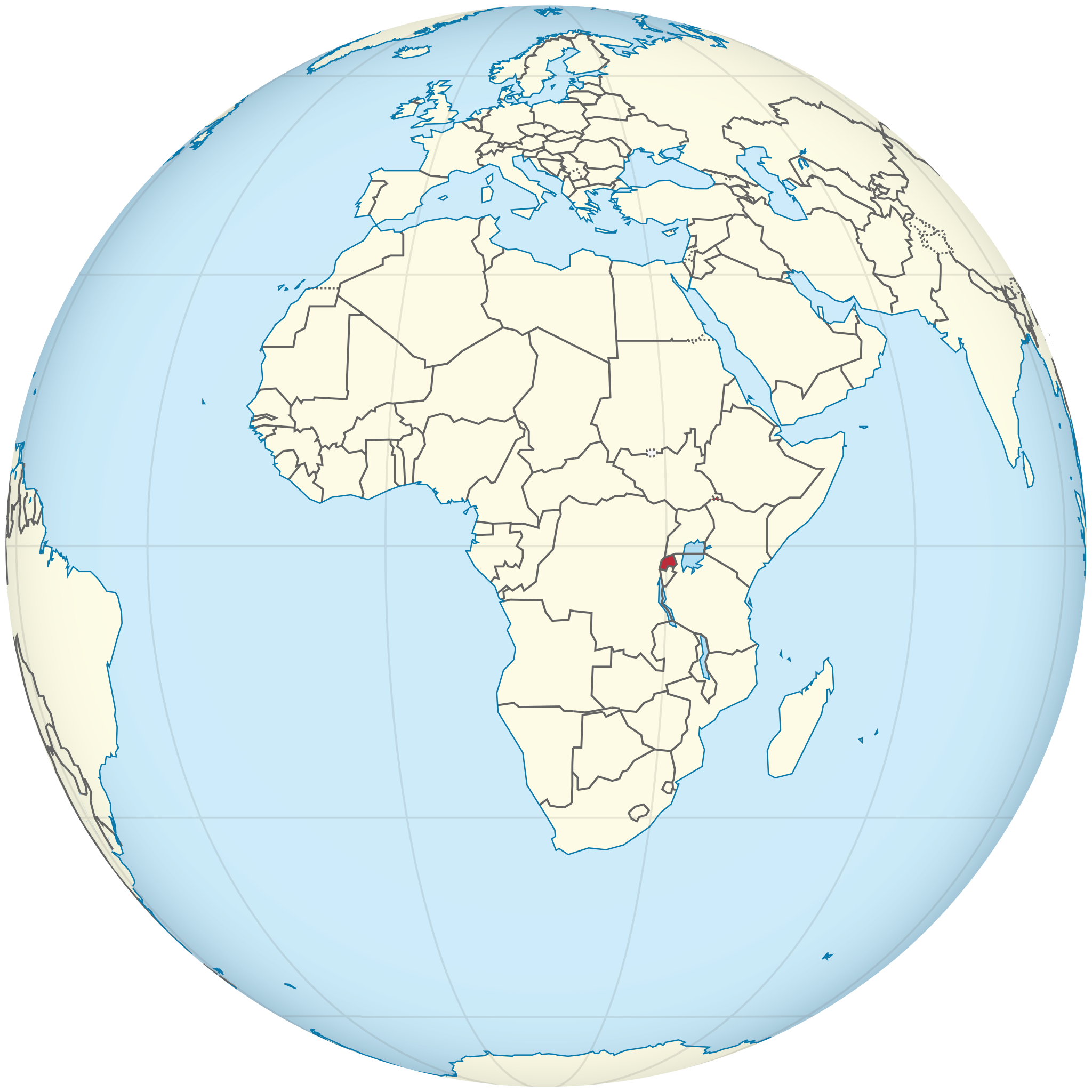
Rwanda on the globe
(licensed under the Creative Commons Attribution-Share Alike 3.0 Unported)
LA VANNERIE DES FEMMES : AGASEKE AND ITS SIBLINGS
INKANGARA
Two traditional baskets are featured on Rwanda’s 5,000 Franc banknote (= approx. US $5). One is the agaseke, the other the inkangara basket.
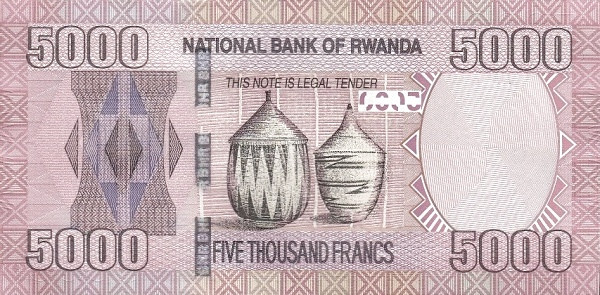
The two traditional baskets might look similar in the banknote drawing, but their differences are nonetheless quite remarkable. Here are some exquisite vintage inkangara baskets.
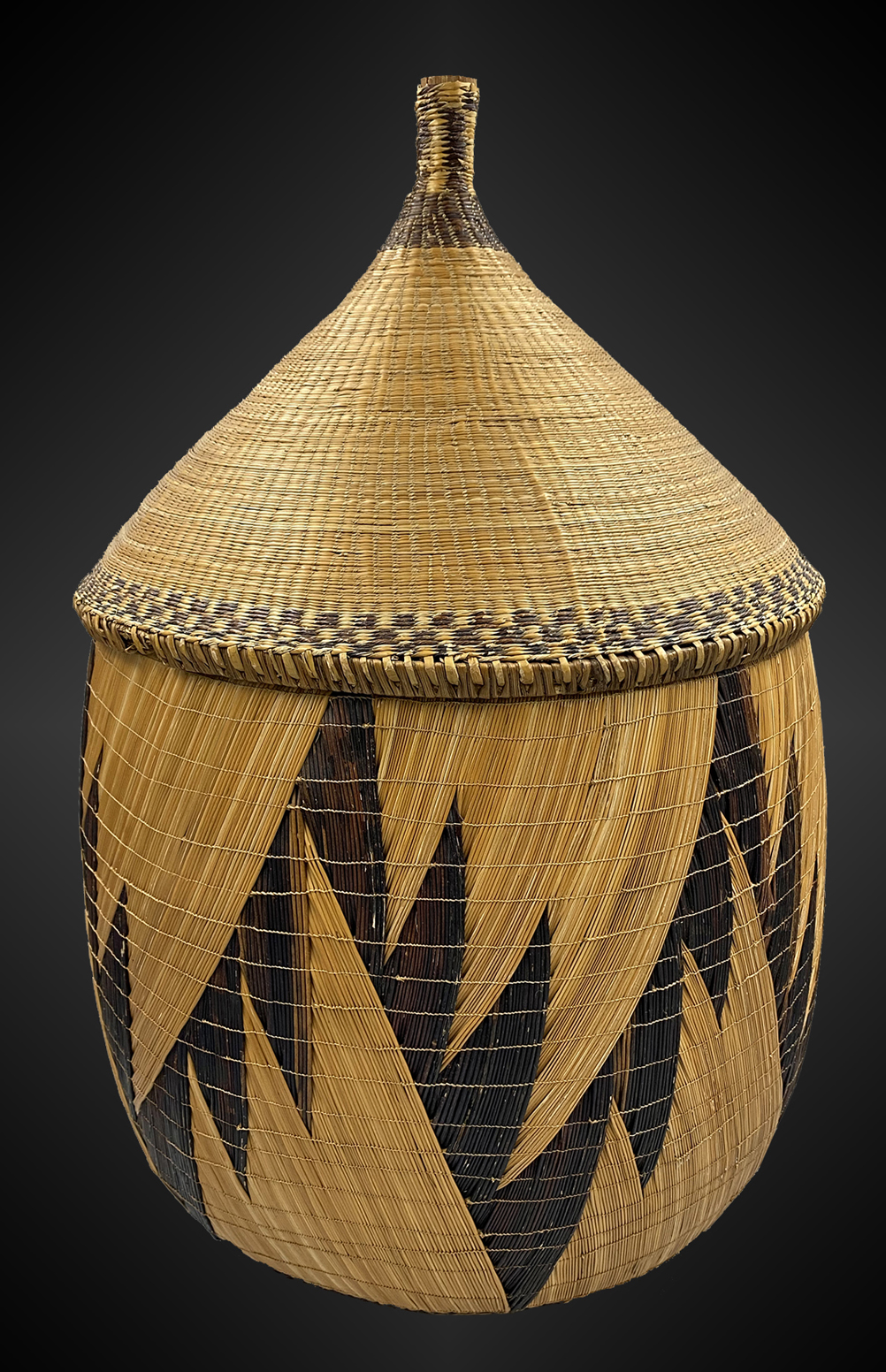
Vintage Tutsi inkangara basket, 20th century. Height 51 cm, diameter 26 cm (20 x 10.23 in).
Pattern: ibitoki, or les régimes des bananes (“bunches of bananas on a tree”).
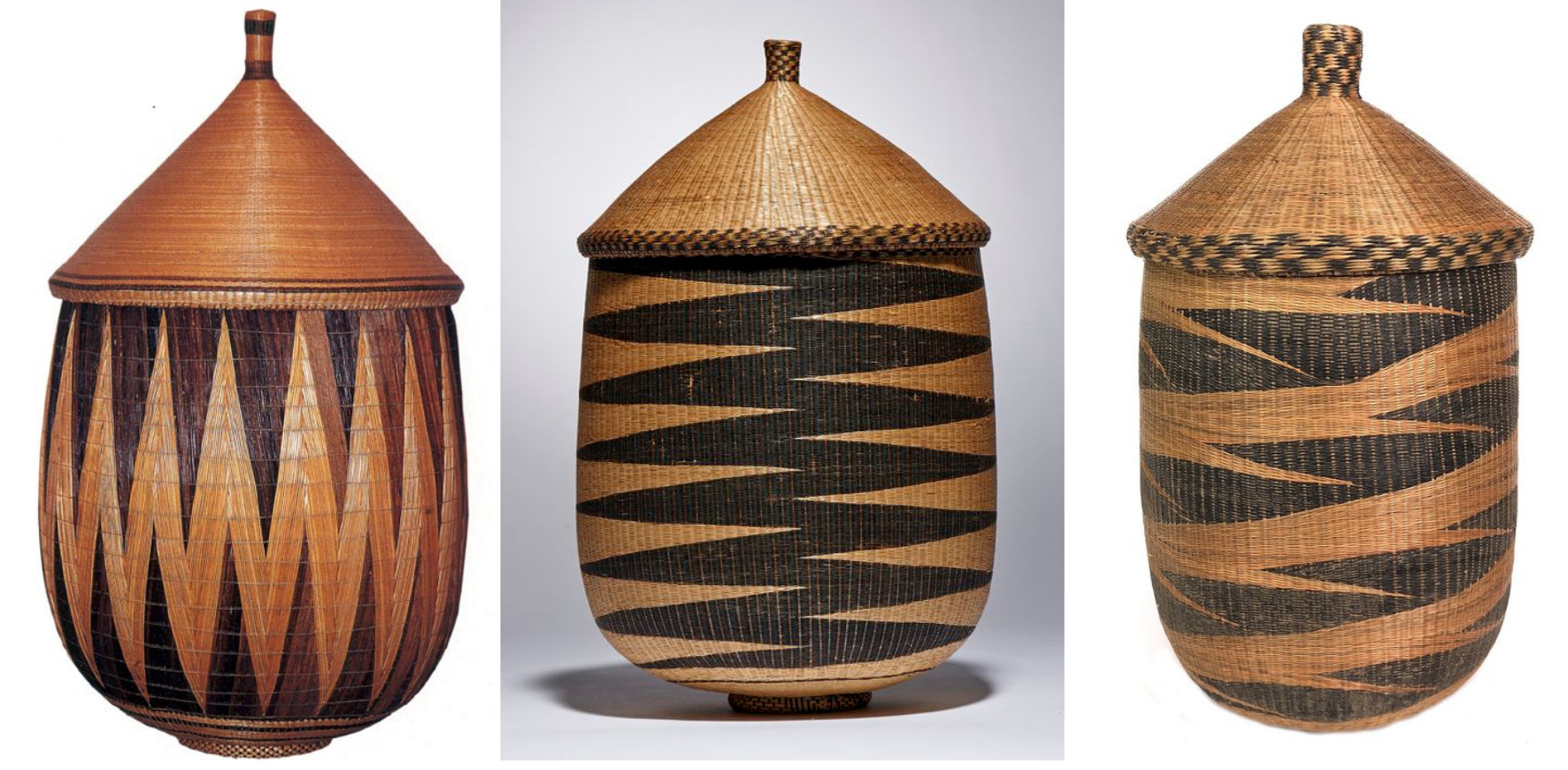
Vintage Tutsi inkangara baskets, from the early/mid-20th century.
Patterns from left to right: amaraza, abashi, ibitoki.

Inkangara basket, Rwanda, second half of the 20th century. Dimensions: height 40.64 cm/16 in, width 40.64 cm/16 in.
The above photo and following one (the inside of the very same basket) are by courtesy of © Africa Direct, an African Art store, headquartered in Denver, Colorado.

The inkangara or agakangara is a lidded basket that came (and still comes) in different sizes and shows a peculiar range of traditional decorative black or red pattern. Its overall shape, function, and weaving techniques are very different from those of the agaseke pieces.
Wider than the agaseke, the inkangara was born as an elegant, prestigious case. It has a stockier and more robust body, and a sturdier and simpler lid, whose tip and lower edge are reinforced with the bark of the Ficus tree and often decorated with a checkerboard pattern (ishaka or ‘the sorghum spike’).
It’s, moreover, a double-layered basket (vannerie doublée in French) with a core and an outer casing, made via a wickerwork technique called igihisi, used also for panels and screens. «The inner core is constructed from rigid bamboo splints, woven together with strands of raffia or sisal and then further embellished with wedge weave to create the bold, crisp designs of the outer surface» (Vanessa Drake Moraga, cit.). In other words, the fine outer surface, often made with Papyrus, Cyperus latifolius grass (intaratara), and the bark of banana leafstalks, covers a coarser deep layer built with narrow, rigid bamboo splints twined with fiber strands. The two different layers are sewn together along the edges (that’s why they are reinforced).
The following pictures show two rows of contemporary inkangara baskets, recently made in the southern Huye district:
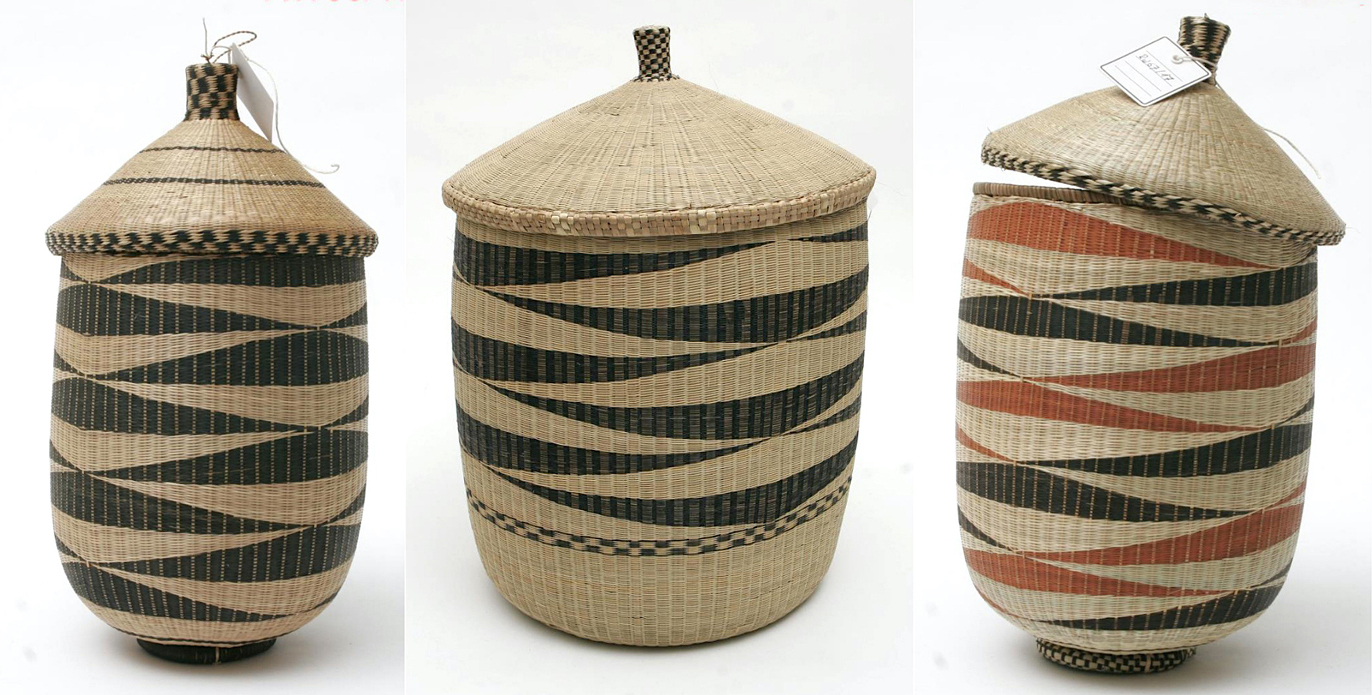
Contemporary inkangara baskets.
The central one is slightly different that the others: it’s a giant container 63 cm (24.8 in) high, while the two side baskets are both 37 cm (14.5 in) high. The giant inkangara has a flat bottom, while the two side smaller ones rest on an ingata, a woven decorated ring. Pattern: ikibero.
© Kulturzentrum Festung Ehrenbeitstein | Landesmuseum Koblenz / Landesmuseum Koblenz, Germany. Photographer: Friederike Brinker
Creative Commons license: CC BY-NC-SA.
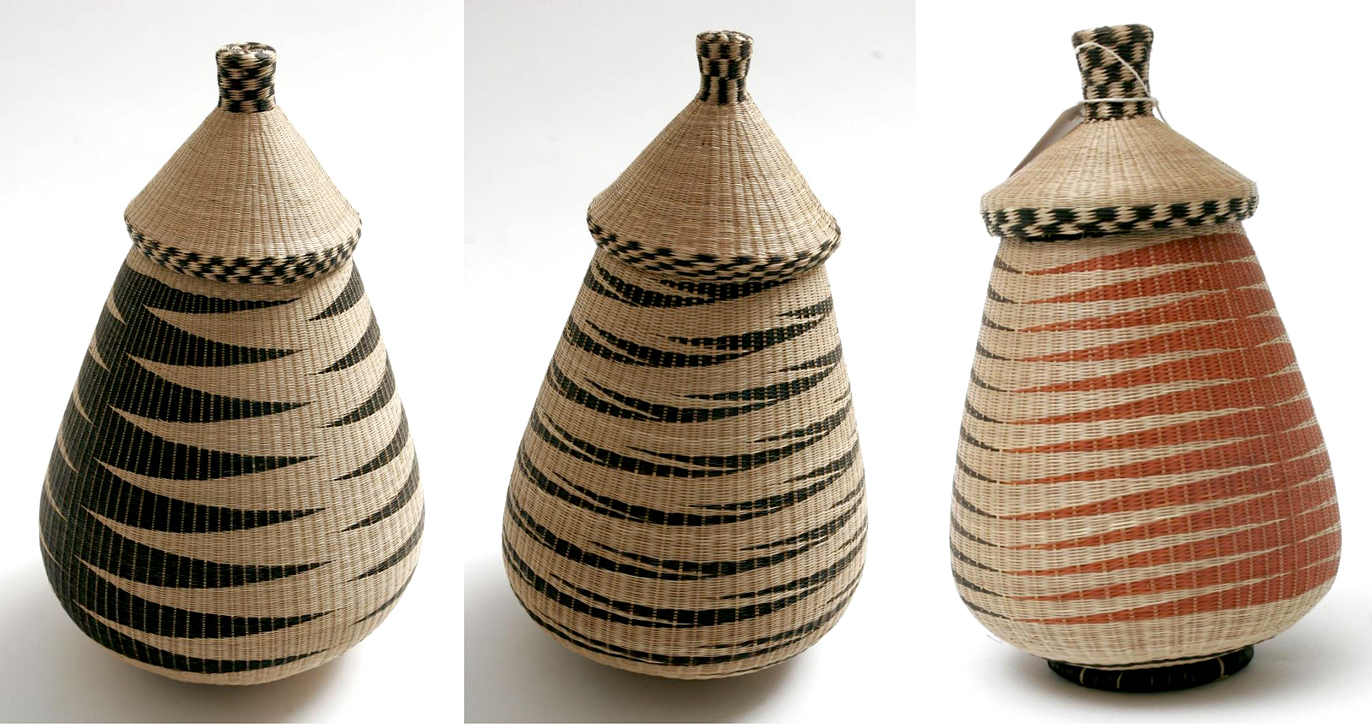
Contemporary medium-sized inkangara baskets.
These pear-shaped pieces are often called nyiramabuno or amabuno. All of them rest on the ingata ring. Heights left to right: 33 cm (13 in), 35 cm (13.7 in), 28 cm (11 in). Pattern left to right: abashi, ifuga, abashi.
© Kulturzentrum Festung Ehrenbeitstein | Landesmuseum Koblenz / Landesmuseum Koblenz, Germany. Photographer: Friederike Brinker
Creative Commons license: CC BY-NC-SA.
Ndamurika by Angel Na Pamella, a Rwandan Gakondo music duo, made up of Ndayishimiye Angel and Bamureke Pamella from Kigali.
The Rwandan traditional instrument you can see and listen to in the video is the INANGA, an ancient plucked trough-zither chordophone. It’s made up of a resonator / string carrier in solid ikivumu wood, carved into a slightly arched, elongated oval shape and then hollowed out to form a trough; its size varies from 75 to 115 cm in length and 25 to 30 cm in width. «Eight notches are carved at each end, articulating seven amenyo (‘teeth’) or amano (‘toes’). A single very long string made of cow tendon is threaded through these notches, and back and forth over the trough to set off eight string segments. Wooden sticks of different diameters can be inserted under each length of string, thus allowing them to be tuned individually» (text by Grinnell College for its Musical Instruments Collection).
This music instrument, the Rwanda’s most revered one, follows the pentatonic scale and was traditionally used as a story-telling or poem reciting instrument. The player simply repeats a short melodic pattern over and over again, in a surprisingly non-monotonous way, and this explains the repeated melody of the song by Angel Na Pamella.
The following picture shows the royal collection of agaseke and inkangara baskets in the Nyanza King’s Palace. They’re not old: the original royal collection was destroyed during the 1994 genocide; these baskets are contemporary, well-made pieces.
Can you differentiate the agaseke baskets from the inkangara ones?
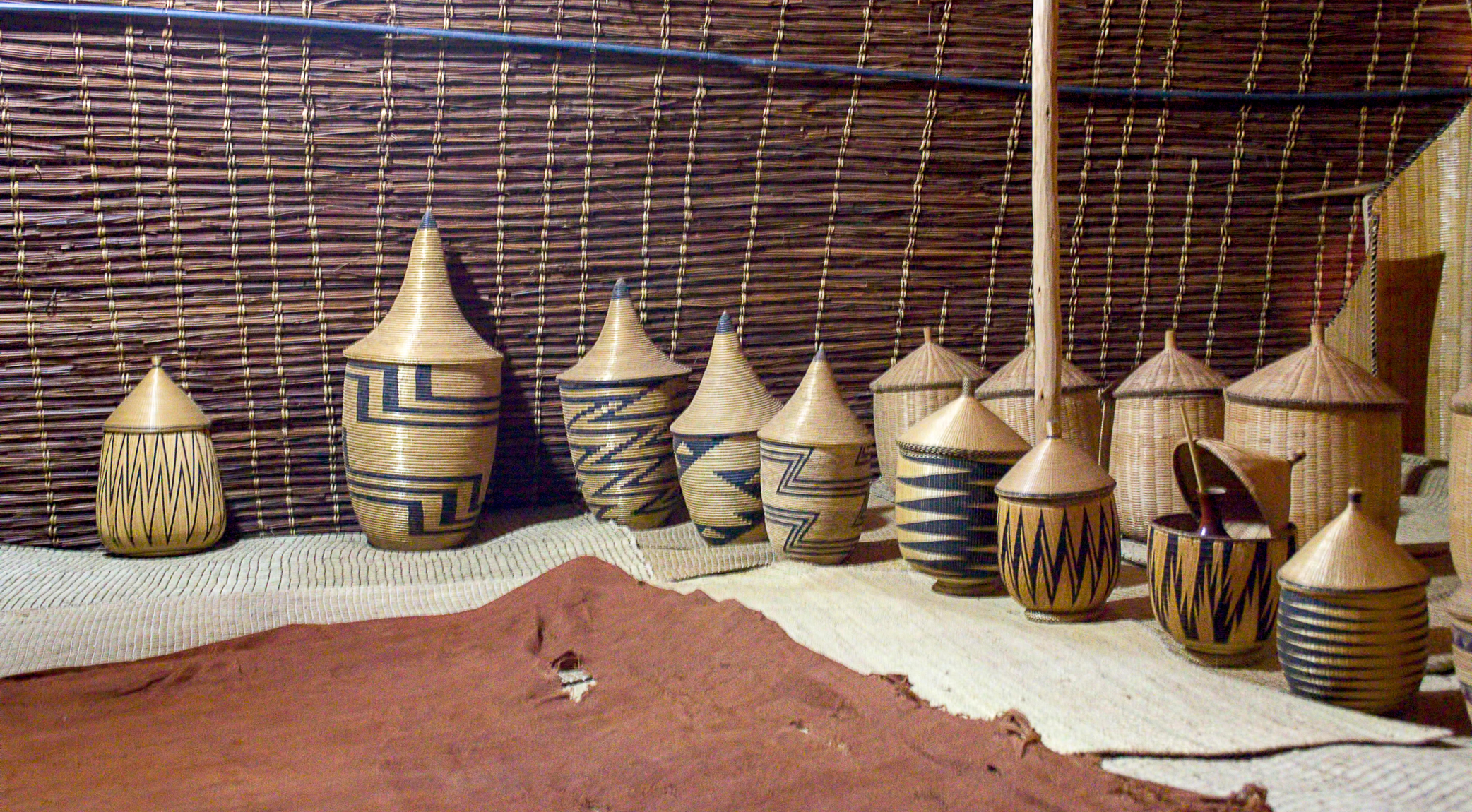
Royal collection of inkangara and agaseke baskets on a side corridor in the Nyanza King’s Palace.
The first on the left is an inkangara, then 4 agaseke and 4 inkangara baskets follow (the second to last contains a beer gourd with straw). The row on the right background is made up of large-sized, undecorated inkangara baskets, once used as sturdy chests, trunks, or suitcases.
By Milton Cogheil / Alamy Stock Photo
INKOKO, AGAKOKO, AND INTANGO
Do you remember the very first video, Nyina W’Abeza by Intayoberana?
At 0.09 and 1.06-1.09, some women are winnowing, namely separating sorghum grains from the chaff.
These gestures – shaking the winnowing woven basket and throwing the mixture into the air so that the wind blows away the lighter chaff or the dirty particles among the grains – are as ancient as the First Agricultural Revolution, at the dawn of the Neolithic.
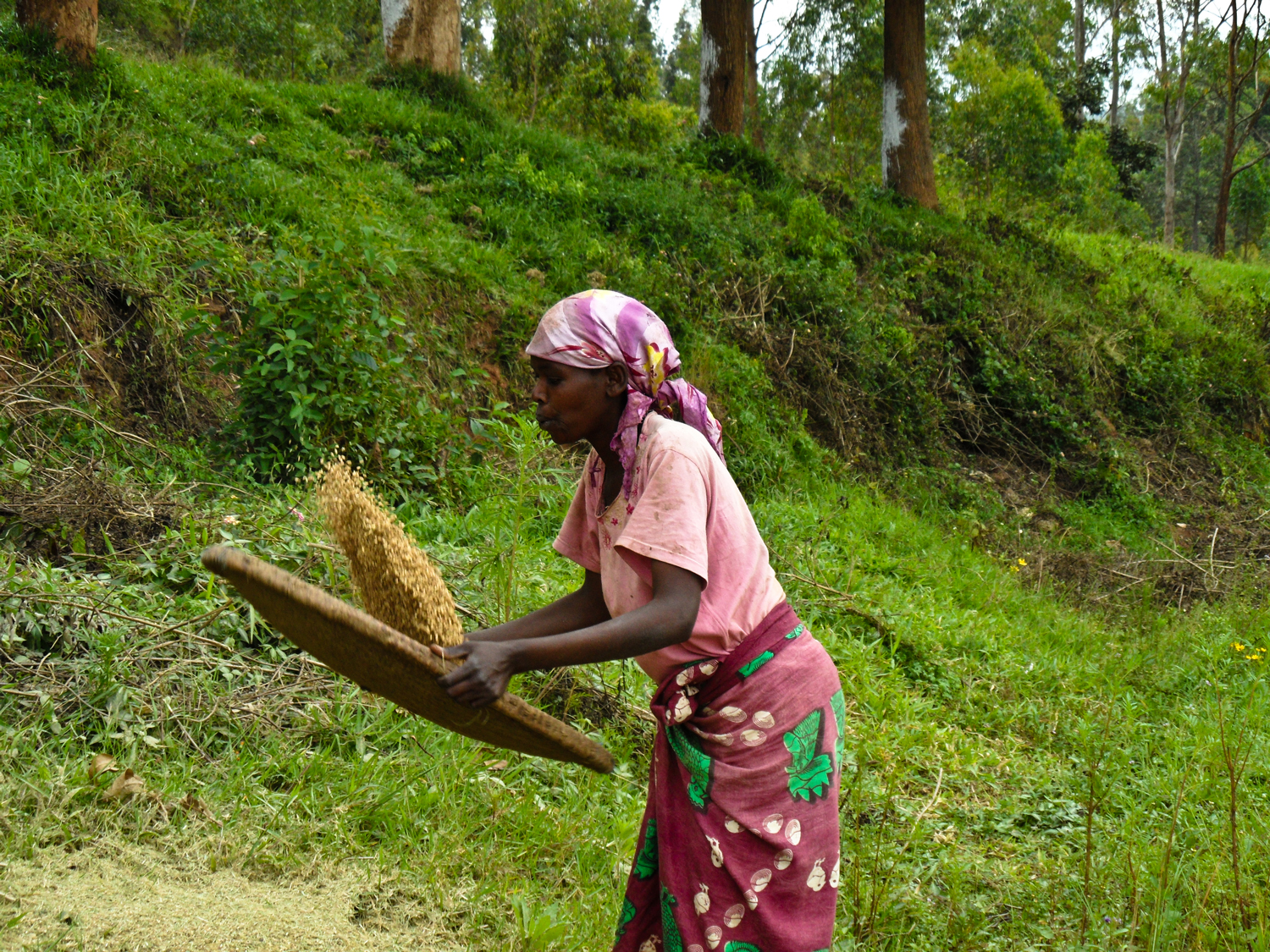
A woman sifts rice with a winnowing woven basket, Rwanda, 2011.
Photo by the International Rice Research Institute (IRRI).
Licensed under Creative Commons Attribution-NonCommercial-ShareAlike 2.0 Generic (CC BY-NC-SA 2.0)

A woman winnows her beans in a woven basket, Rwanda.
Photo by One Acre Fund, a non-profit social enterprise that supplies financing and training to help smallholders grow their way out of hunger. One Acre Fund works in Rwanda, Ethiopia, Kenya, Burundi, Tanzania, Malawi, Uganda, Zambia.
The woven trays take different names in Kinyarwanda: the ikidasesa or ibidasesa is a large mat, used to dry grains or beans in the sun; the intara or urutaro is the most common winnowing basket for cleaning sorghum, maize, rice, beans, or cassava flour. The inkoko is a smaller tray, often used as a platter or a food tray.
Finally, the agakoko or udukoko, a diminutive of inkoko, is a miniature winnowing basket of a slightly convex shape, once used to present gifts and offerings to esteemed guests or as a decorative piece in noble households. It’s finely woven, following the technique of double basketry or igihisi (the very same used for the inkangara baskets), and decorated with the traditional black or red designs. Below, some agakoko baskets of different small sizes, likely from the first half of the 20th century.

Old inkoko and agakoko baskets on display at the Royal Museum for Central Africa, in Tervuren, Belgium.
(Photo licensed under the Creative Commons CC0 1.0 Universal Public Domain Dedication)
The details of the antique igihisi technique can be more clearly noticed in the following contemporary pieces, woven in keeping with tradition.

Left to right:
Agakoko bowl, Huye, Rwanda 2017. Dimensions: height 5 cm, diameter 25.50 cm. Pattern: ibitoki, or les régimes des bananes (“bunches of bananas on a tree”).
Agakoko bowl, Huye, Rwanda 2017. Dimensions: height 4.5 cm, diameter 26 cm. Pattern: abashi.
© Kulturzentrum Festung Ehrenbeitstein | Landesmuseum Koblenz / Landesmuseum Koblenz, Germany. Photographer: Friederike Brinker
Creative Commons license: CC BY-NC-SA.
A single agakoko basket – probably you’ve already noticed it – is not as decorative as a row or a group of them. This is true also for agaseke and inkangara pieces and in general for all Rwandan prestige basketry: the pieces were – and still are – created to be displayed in a group, side by side, so that their black and red designs might give rise to a sort of visual ‘concerto’, full of dynamism and contrasting movements. In other words, the vibrant and bold geometric designs are created to complement each other and make a whole greater than the sum of its parts.
The following is an old miniature, round-shaped, flat mat, woven as an agakoko, according to the igihisi technique, and probably used as a prestige salver or a gift tray. It’s called intango.

Grass plaited mat, patterned in natural and deep purple, with mauve border, Rwanda, before 1948. Dimensions: height 0.3 cm, width 15.5 cm.
© The Trustees of the British Museum, London, UK.
Under license Creative Commons Attribution-NonCommercial-ShareAlike 4.0 International (CC BY-NC-SA 4.0)
The two following pictures depict two pairs of respectively old and contemporary intango mats, all made by using the antique coiling technique of uruhindu (look at their respective centers).
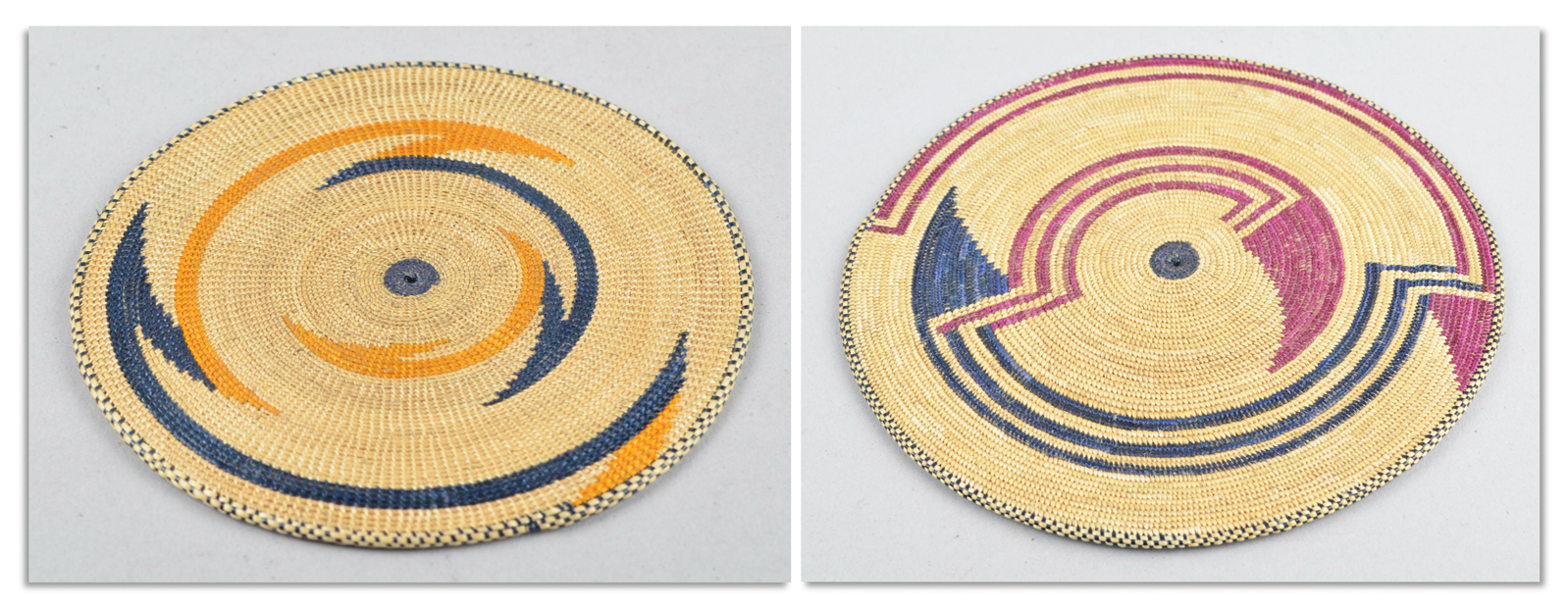
Two woven mats, Rwanda, from the first half of the 20th century. Width left to right: 9.50 cm and 12.20 cm.
© The Trustees of the British Museum
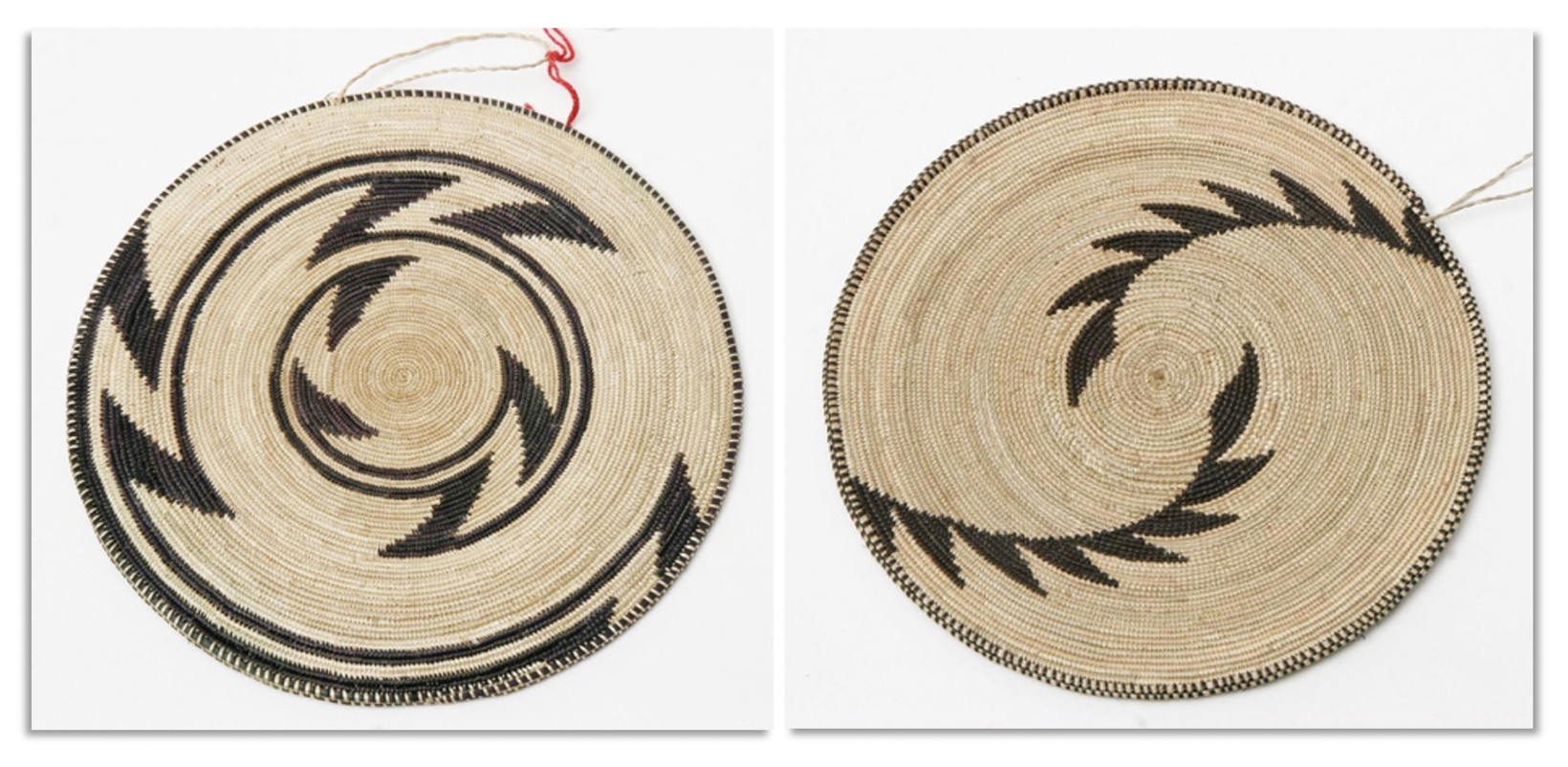
Two contemporary intango mats, handmade in Gahororo and Mbazi (Huye district), Rwanda, 2017.
Diameter left to right: 14 cm and 13.50 cm.
Pattern left to right: amaraza and ibaba or the ‘bird’s wings’.
© Kulturzentrum Festung Ehrenbeitstein | Landesmuseum Koblenz / Landesmuseum Koblenz, Germany. Photographer: Friederike Brinker
Creative Commons license: CC BY-NC-SA.
ARCHITECTURAL PANELS, SCREENS, AND MATS
Similar to the Nyanza King’s Palace, the traditional household of wealthy Rwandans was once full of panels and screens that had many functions at once. They were architectural elements used as room dividers – namely to enclose a specific area or separate the sleeping zone from the meeting one – and filter sunlight and stranger’s glimpses. They were decorative elements as well, displayed in a creative row of many to give rhythm, dynamicity, and social status to domestic interiors.
As to the screens, the most used were the insika and the inyeqamo (or inyegamo) types, both decorated with vibrant geometric designs.
The insika screen has a rectangular shape of variable height, slightly curved as it was traditionally inserted between two hut pillars. It was (and still is) woven following two techniques: the igihisi, the very same of the inkangara baskets, or a different antique one, called insobekerane or technique tissée in French (it consists of intersecting horizontally and vertically arranged strips of bamboo or papyrus).
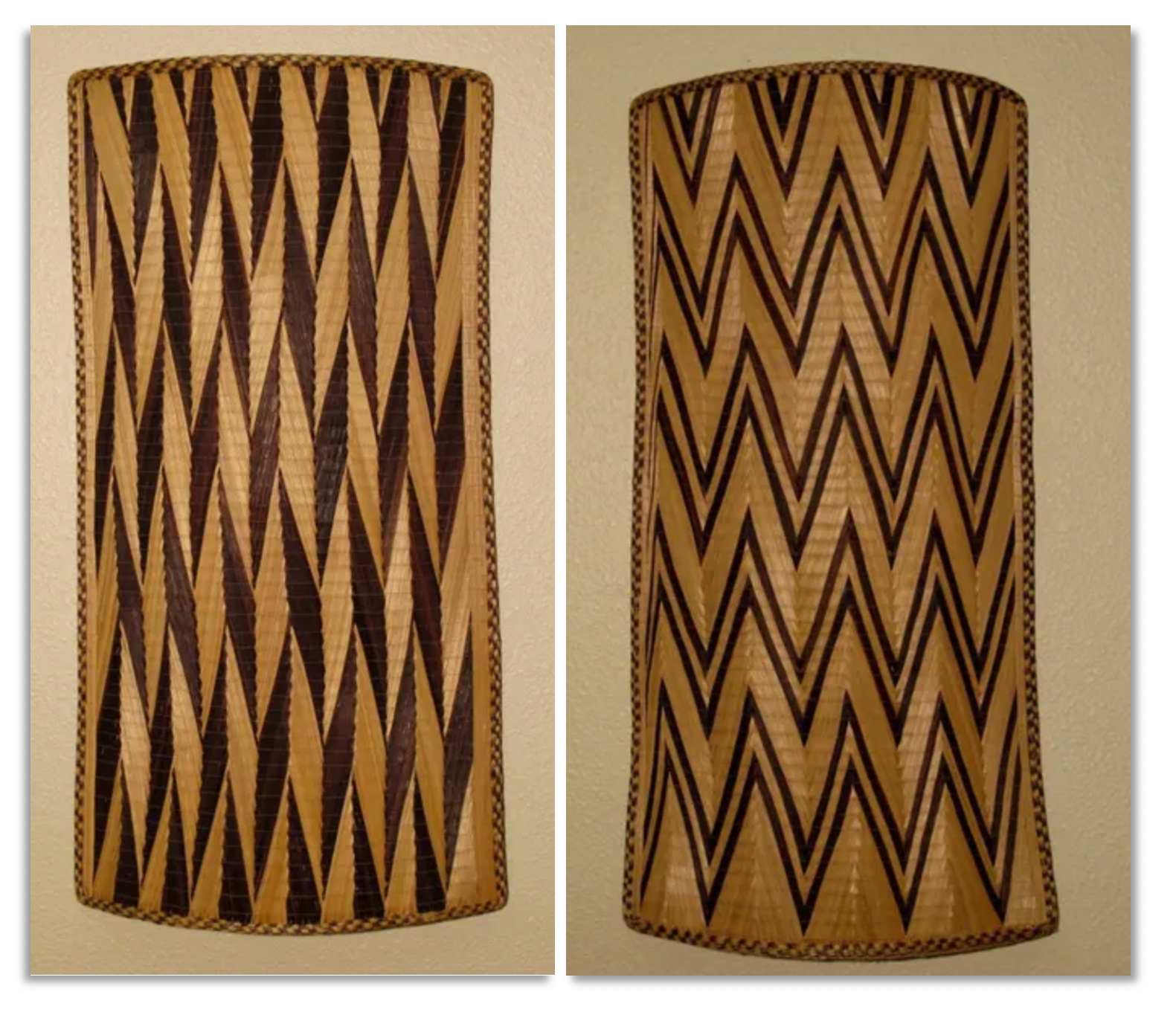
Two short insika screens from the 1990s.
Today, the insika screens are used as wall decorative panels. Here are four impressive specimens, 2 m tall, made in 2002.

Two insika screens, 2002, Rwanda.
Dimensions: height 200 cm, width 56 cm. Technique: igihisi. Patterns: var. amaraza, var. igishuli.
Materials: inner layer in bamboo, peeled papyrus strips called insasanure on the outside.
© Kulturzentrum Festung Ehrenbeitstein | Landesmuseum Koblenz / Landesmuseum Koblenz, Germany. Photographer: Friederike Brinker
Creative Commons license: CC BY-NC-SA.
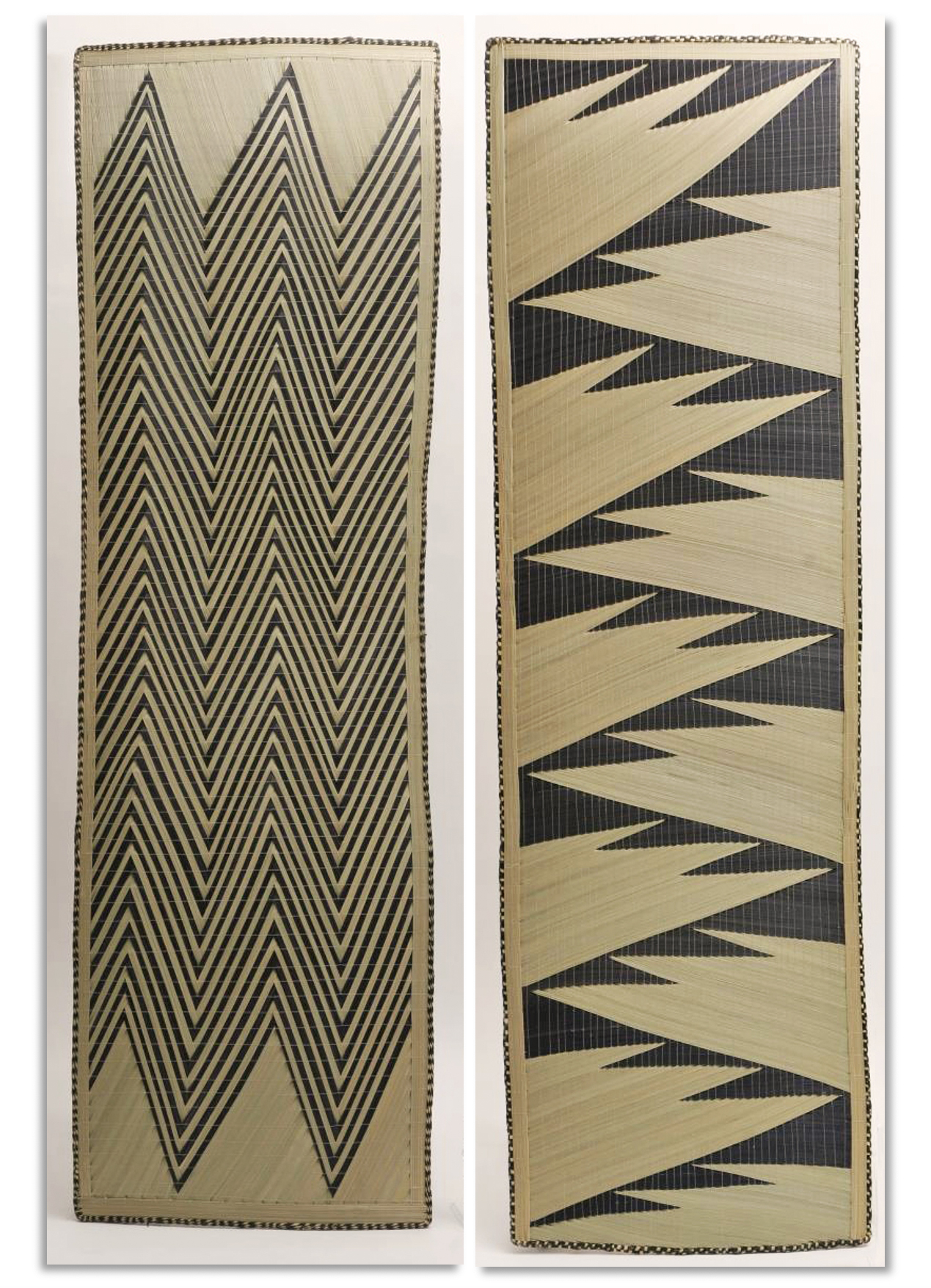
Two insika screens, 2017, Nyanza District, Rwanda.
Dimensions left to right: height 204 cm, width 62 cm; 199 cm, 62 cm. Technique: igihisi. Patterns: amaraza, ibitoki.
Materials: inner layer in bamboo, peeled papyrus strips called insasanure on the outside.
© Kulturzentrum Festung Ehrenbeitstein | Landesmuseum Koblenz / Landesmuseum Koblenz, Germany. Photographer: Friederike Brinker
The inyeqamo (or inyegamo) rectangular-shaped panels were used as flexible elements that could be rolled up to allow passage. They were finely woven on an underlying frame using the umugabo technique and usually divided into two vertical fields showing different designs.
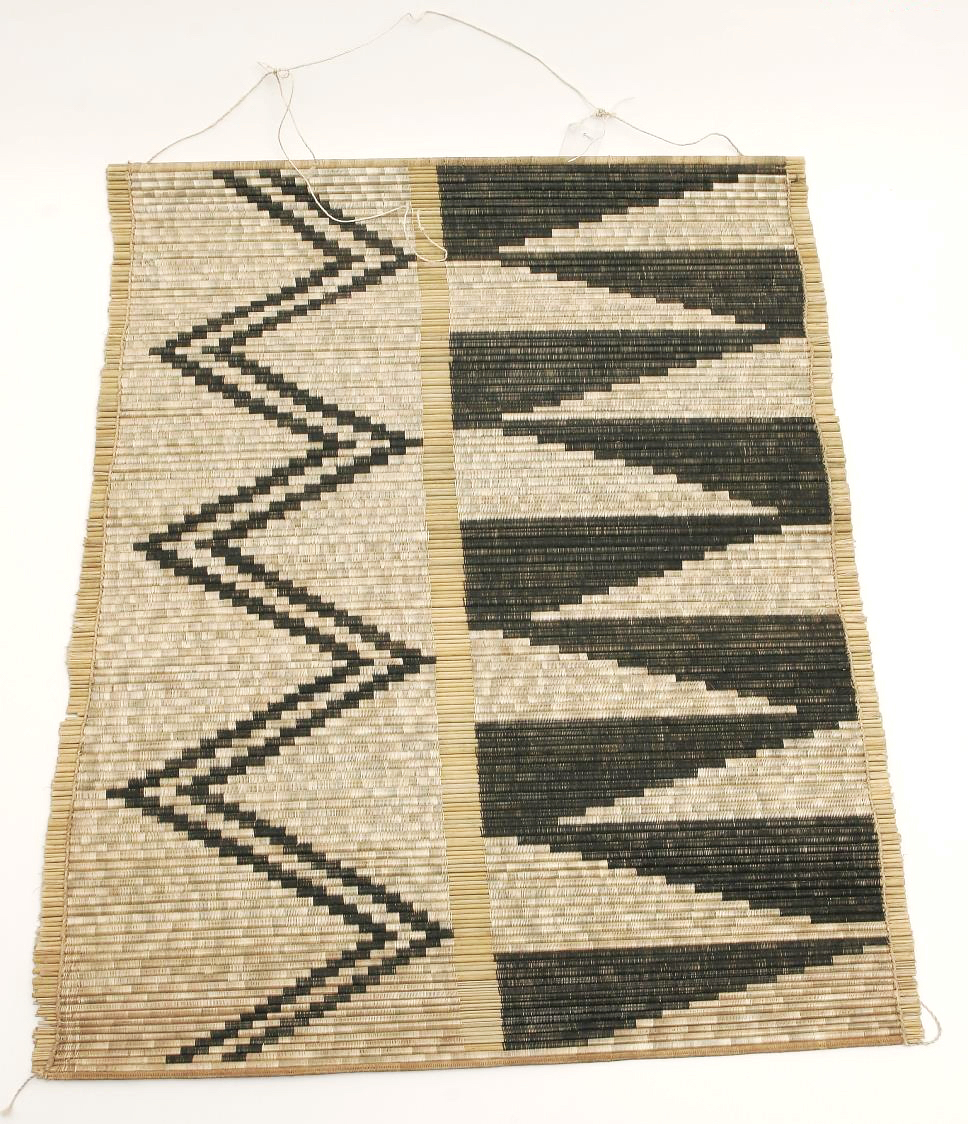
Inyegamo roll, 2017, Secteur Save, Gisagara District, Rwanda.
Dimensions: height 200 cm, width 80 cm. Technique: umugabo. Patterns left to right: amaraza, ikibero.
Materials: inner layer in bamboo, peeled papyrus strips called insasanure on the outside.
© Kulturzentrum Festung Ehrenbeitstein | Landesmuseum Koblenz / Landesmuseum Koblenz, Germany. Photographer: Friederike Brinker
Creative Commons license: CC BY-NC-SA.
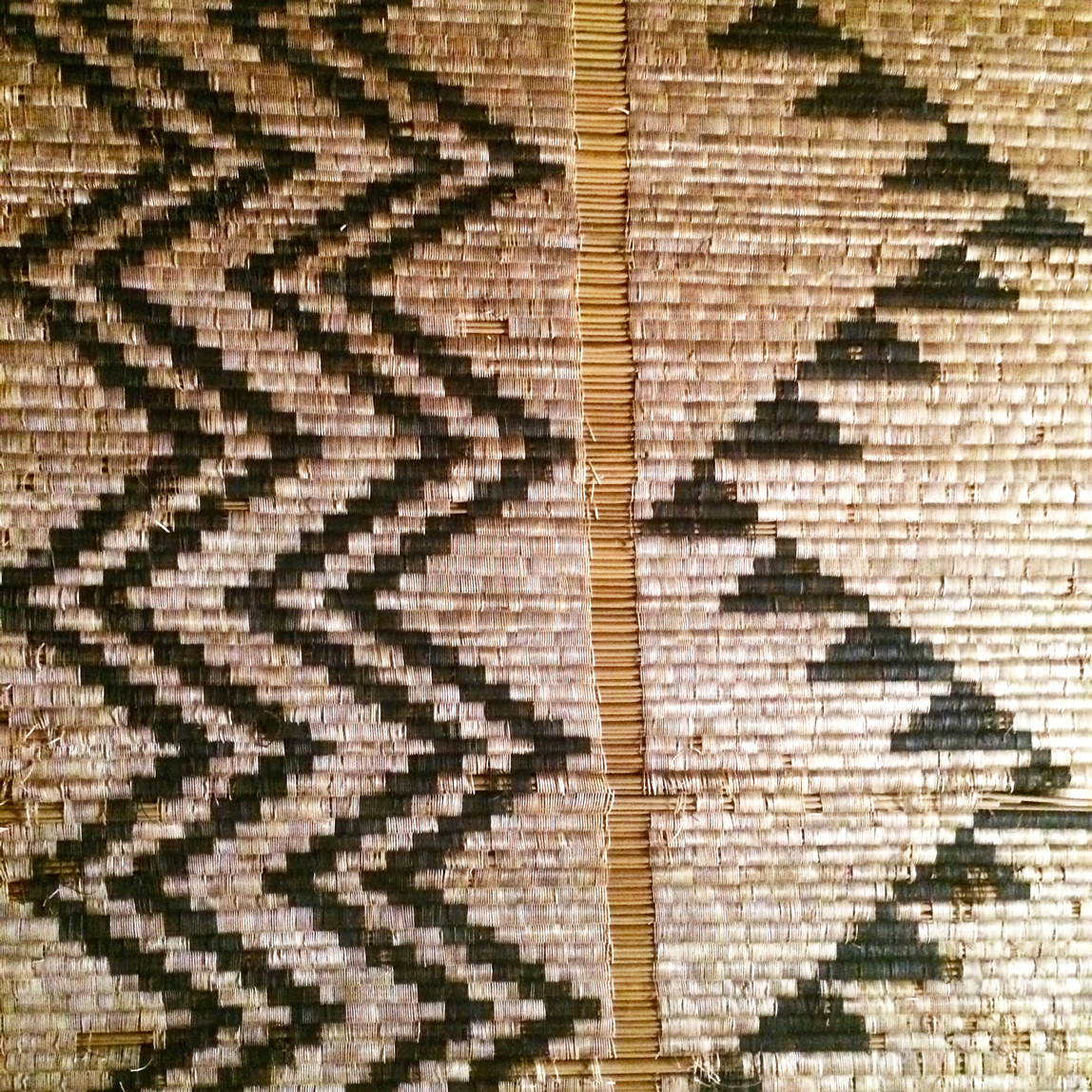
Close-up of a vintage inyeqamo roll, Nyanza, Rwanda.
Patterns left to right: amaraza, ikirobera.
Photo by Rachel Strohm, 2014.
Licensed under Creative Commons Attribution-NoDerivs 2.0 Generic (CC BY-ND 2.0)
In the past noble households and in the King’s Palace at Nyanza, the inyeqamo roll was used to block or allow access to the man’s bed: it worked as a curtain that marked the entrance of the bed area from the central room. However, this was only used by the man’s side: the woman had a different, less direct entryway to avoid passing over his husband. Thus, in case of an attack or an emergency, the husband was the very first to get out of bed.
Other traditional elements of every wealthy household of the past were the multi-purpose woven mats, used as coverings, carpets, large trays, sleeping area mats. The umusambi mats were woven via the ingoyi technique and finely decorated with geometric motifs that could complement each other or even better, ‘enter into resonance’ once on the floor.

Three umusambi mats, 2017, Secteur Mbazi, Huye District, Rwanda.
Dimensions left to right: lenght 239, width 106 cm; 202 cm and 70 cm; 234 cm and 112 cm. Technique: ingoyi.
Materials: grass, sisal, braided black banana bark.
© Kulturzentrum Festung Ehrenbeitstein | Landesmuseum Koblenz / Landesmuseum Koblenz, Germany. Photographer: Friederike Brinker
Creative Commons license: CC BY-NC-SA.
MODERN VASES
«La vannerie moderne s’est fortement inspirées de modèles importés d’objets en metal ou en bois» [Modern basketry has been strongly inspired by metal or wooden imported objects] (Célestin Kanimba Misago, see Bibliography). Moreover, in the last decades, the Rwandan art of basketry has reinterpreted some non-African vase forms, like the ‘pear-shaped’ or the ‘globular’ ones.
Among the modern pieces, the so-called Huye floor vases (as they are made in the Huye District) definitely stand out: they are usually very tall and impressive, and there’s no picture that might do justice to their beauty and ‘physical presence’.
The following is a vintage Huye floor vase from my collection: it’s 61 cm (24 in) tall, with warm and charming natural colors.

The huye vases, often called “wedding vases”, are usually meticulously woven in black and red. The impressive vase below, just under a meter in height, has two faces, a red and a black one, and is a double-layered piece, as you can see from the enlarged pic.

Wedding vase, Rwanda, second half of the 20th century. Dimensions: height 99 cm/39 in, width 35.56 cm/14 in.
The above photo and the two following ones are by courtesy of © Africa Direct, an African Art store, headquartered in Denver, Colorado.
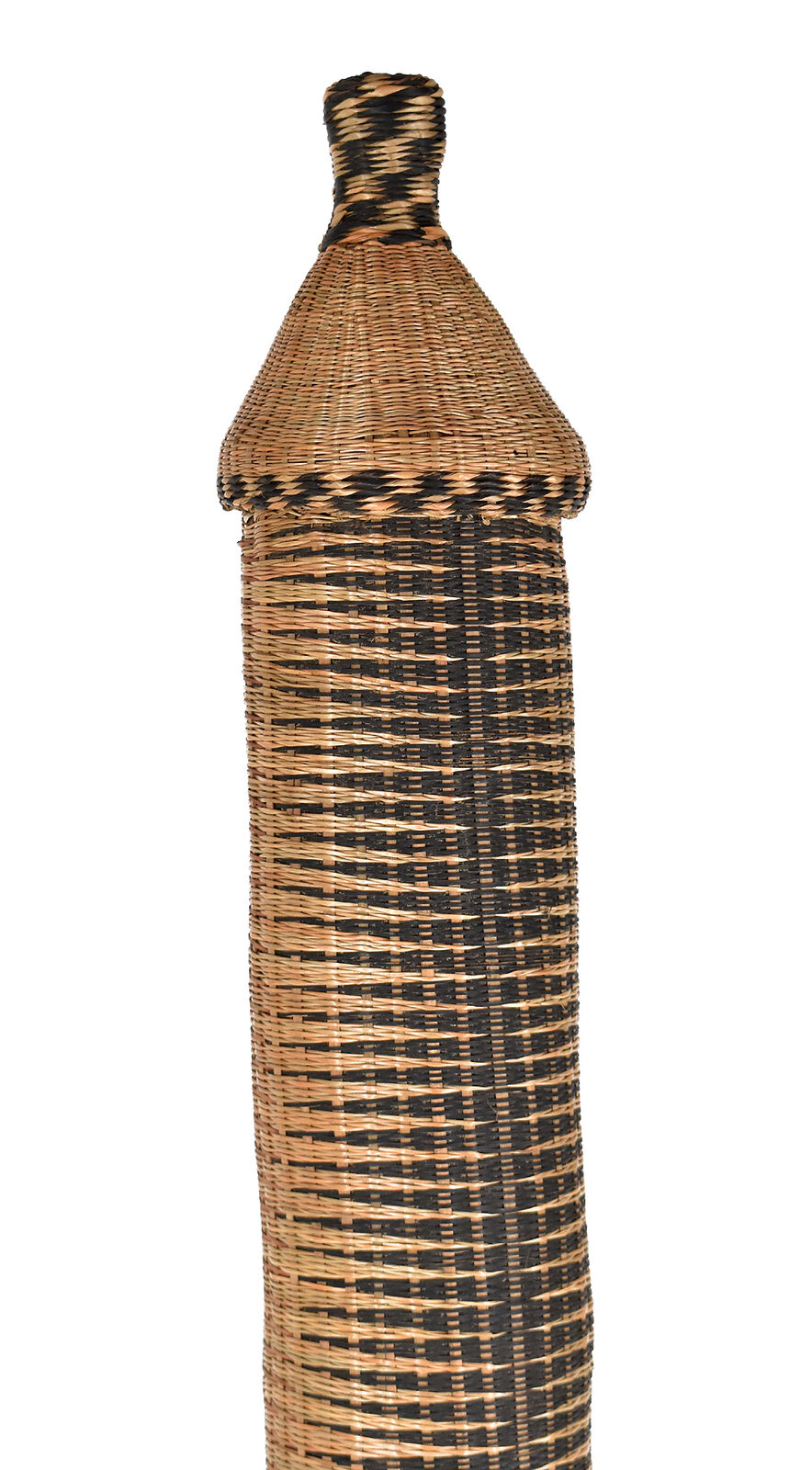

Eventually, a contemporary masterpiece of Rwandan basketry: the following set of three Huye floor vases is spectacular and – dare I say – majestic. The three vases are approximately 157.48 cm/62 inches tall and proudly show a gracefully inclined giraffe neck. It’s impossible not to notice them, as they can ‘fire up’ every space with their presence. Each basket requires almost a whole month of daily work, and the entire set is quite expensive (a few thousand dollars).

Set of three Rwandan baskets, 21st century. Dimensions: height 157.48 cm/62 in, width 33.02 cm/13 in.
The above photo and all of the following ones are by courtesy of ©Brendan Bass Showroom, Dallas Design District, Dallas, Texas, US.
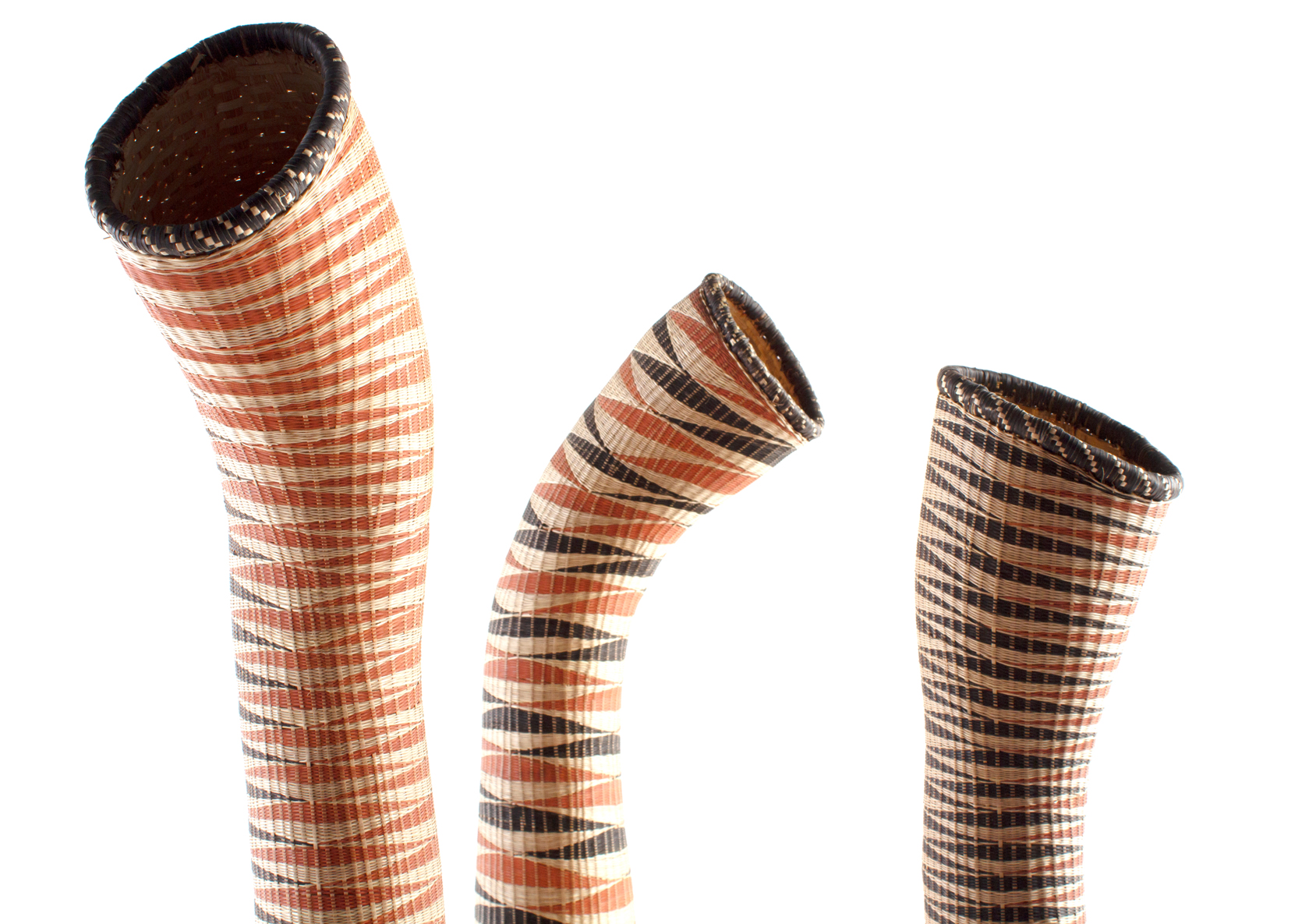
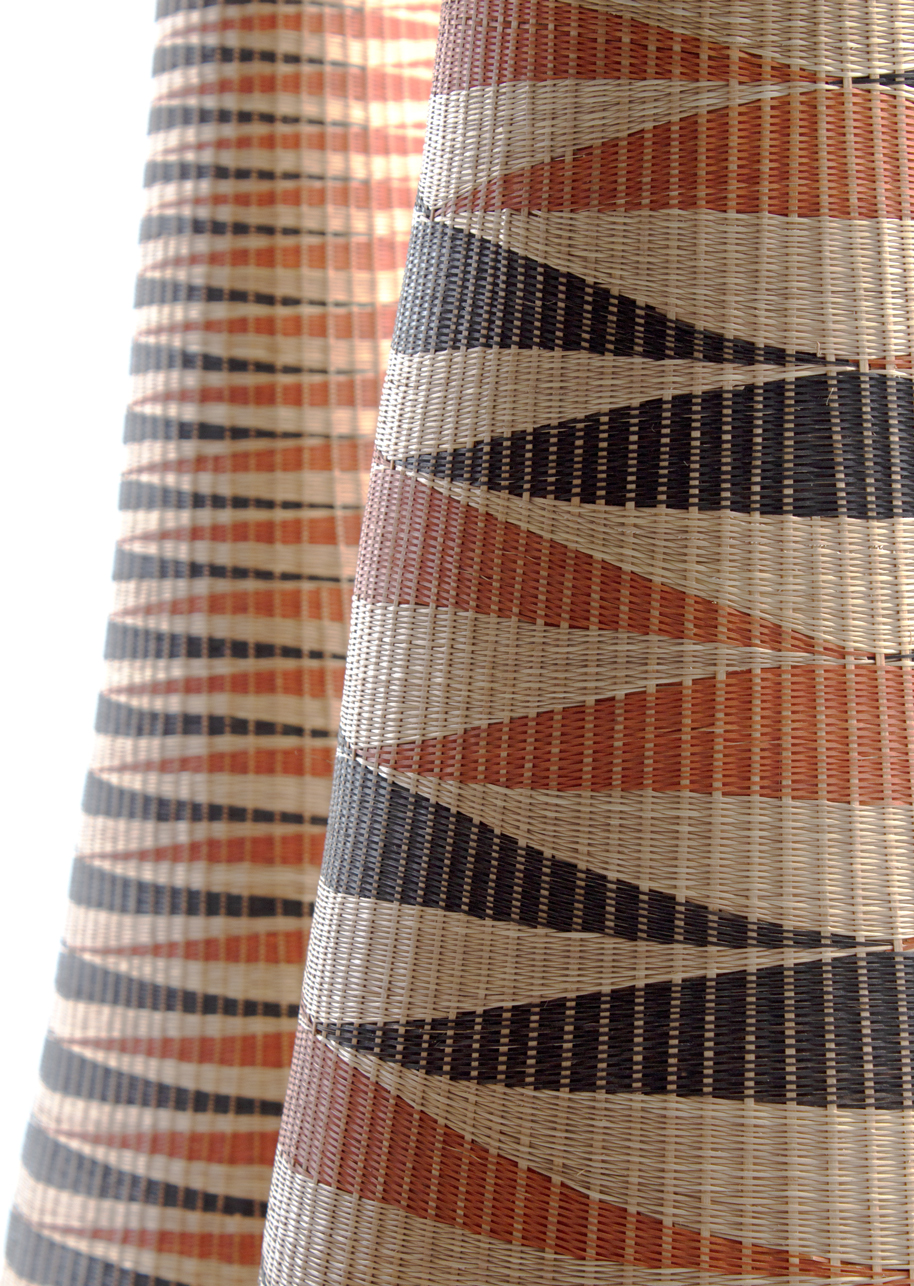
Today, the current production of woven objects in Rwanda is branched out and diversified: you can find small agaseke-souvenirs worth a few dozen bucks, woven earrings, bags and lampshades, as well as expensive, giant, refined vases. The top-quality pieces, however, are still too few and too anchored to the same old, ‘canonical’ forms. I hope that the new generation of young creatives who makes Kigali a lively city could master the ancient art of basketry, transform the panorama, and push aesthetic research far beyond the established modules of the past, without giving in to the temptation to please or gratify the average taste of buyers.
Nirere Shanel, Igisingizo (Praise), 2017
Ruth Nirere, aka Miss Shanel or Ninere Shanel is one of Rwanda’s leading female artistes, singer and actress.
This song is a tribute to Rwandan motherland, to maternity and Rwandan mamas. The newborn she’s breastfeeding is obviously her baby.
Did you notice the imigongo panels? (1.46-49, 2.22-24 in the video)
I’m sure you noticed the impressive Huye floor vases, the wall panels, the collection of woven plates on the wall, and may be some agaseke baskets glowing in the dark.
But what about the imigongo panel behind Nirere Shanel?
We saw this kind of panels applied to walls and doors of traditional huts. Below, some contemporary small-sized panels made via this Rwandan traditional art-form that makes use of the cow dung.
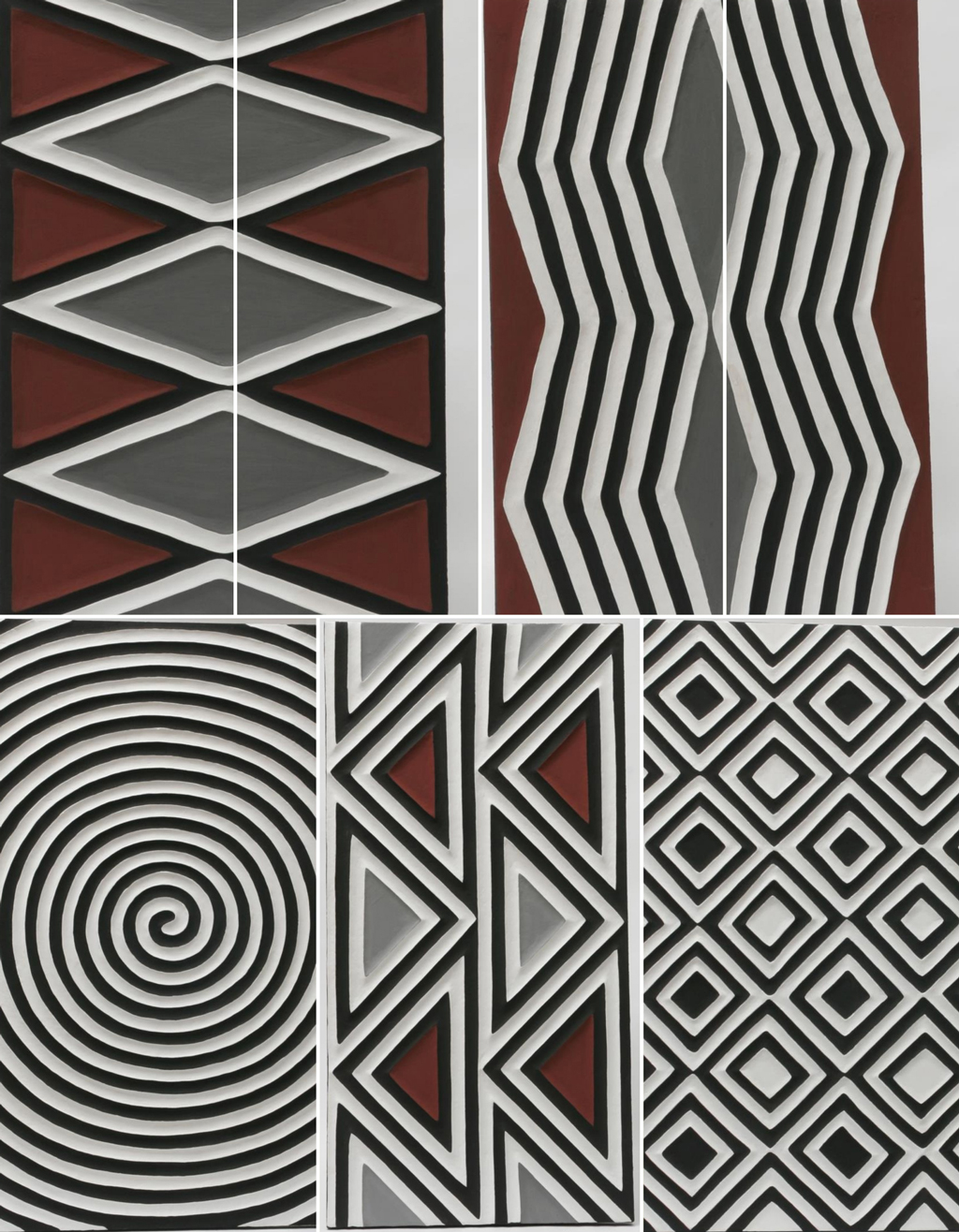
Contemporary Imigongo panels, Rwanda.
By Kulturzentrum Festung Ehrenbeitstein | Landesmuseum Koblenz / Landesmuseum Koblenz, Germany. Photographer: Friederike Brinker.
(Creative Commons license: CC BY-NC-SA)
WEAVING PEACE
The antique and contemporary women’s basketry covers a wide range of woven masterpieces, but the agaseke basket is definitely the most iconic of all. It’s a symbol of Rwanda and its roots. It’s an image of peace so salient to be at the center of the national seal. Once, it was gifted (often full of food or precious items) as a sign of friendship or alliance; it was also a traditional homage or tribute paid to influential people. However, the symbolic force of this basket goes far beyond its traditional use and hidden meaning. Today, Rwandans are coming through years of fights, armed clashes, and genocide, and they are doing it by laboriously weaving peace. Literally.

Alyx Becerra
OUR SERVICES
DO YOU NEED ANY HELP?
Did you inherit from your aunt a tribal mask, a stool, a vase, a rug, an ethnic item you don’t know what it is?
Did you find in a trunk an ethnic mysterious item you don’t even know how to describe?
Would you like to know if it’s worth something or is a worthless souvenir?
Would you like to know what it is exactly and if / how / where you might sell it?
